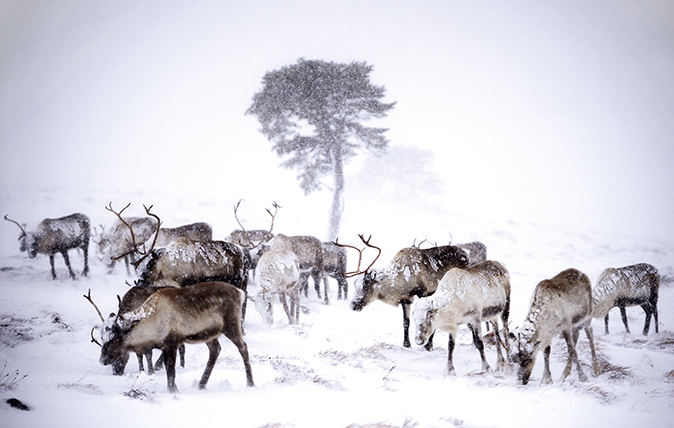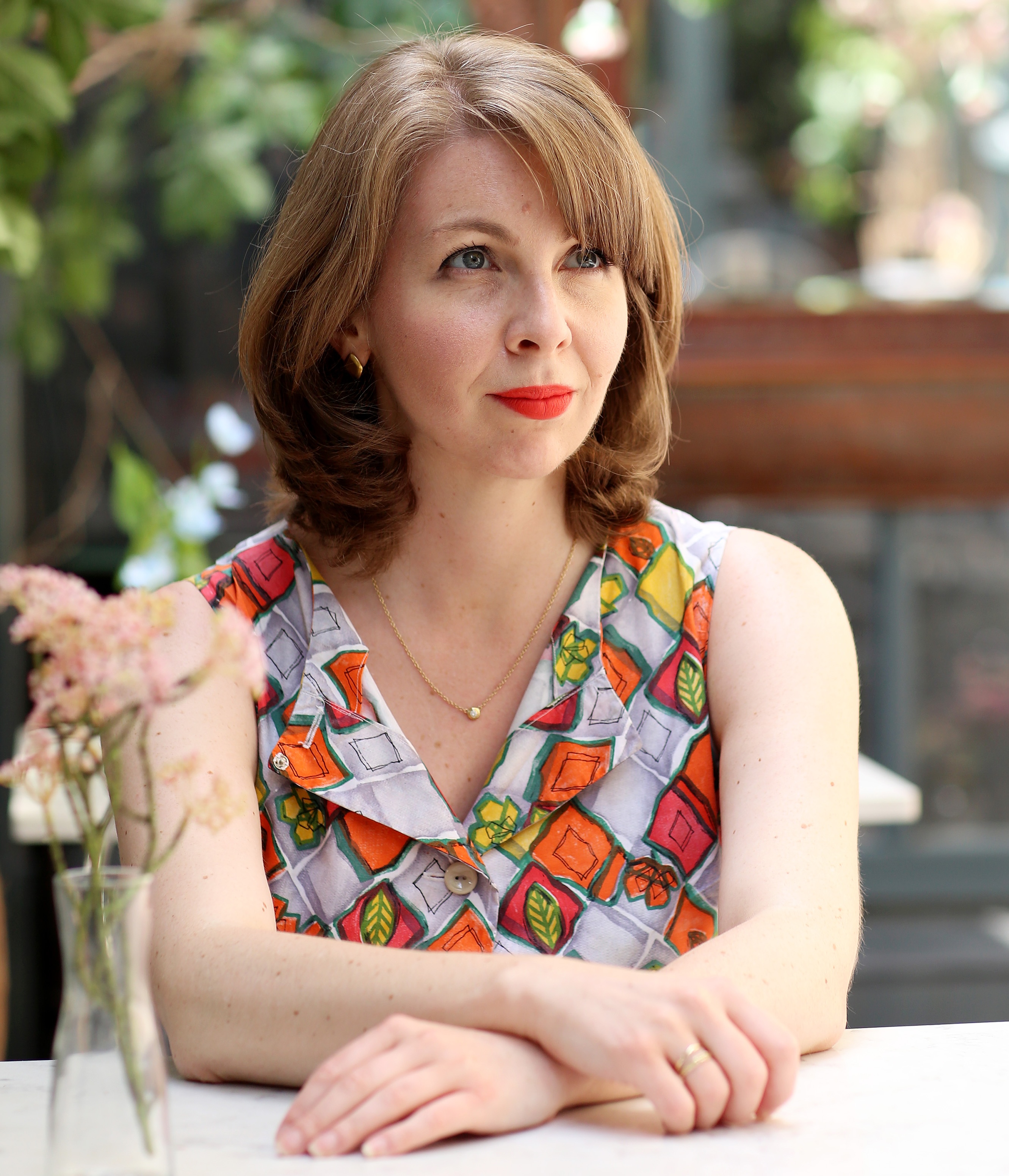Meet the real Rudolph the red-nosed reindeer
With sleigh bells ringing in her ears, Emma Hughes heads north to Scotland, where she discovers that reindeer aren’t just for Christmas.


At this time of year, you have to go looking for them. Setting off up the hill in a convoy of cars, you bump slowly along a mountain road, watching as the Cairngorms fade in and out of view behind the fog. then, you’re given the signal to switch off your engine— the rest of the journey has to be made on foot, over rough, icy and frequently snow- covered ground. the wind, which can get up to 70mph, nearly lifts you off your feet and the cold gets right into your bones. No matter how many items of clothing you’re wearing, it almost certainly won’t be enough.
Then, suddenly, you glimpse something. A set of antlers, taking shape at the edge of the mist, like a mirage—then another and another. As they approach, you hear the pat pat pat of dozens of hooves on turf. this is Britain’s only wild herd of reindeer and Christmas is their peak season.
‘Yes, it is a bit hectic at the moment,’ admits Andi Probert, one of the Cairngorm Reindeer Centre’s herders, with masterful understatement. ‘We approach this time of year with a certain amount of trepidation, but it’s a lot of fun, too.’
For the past six years, Andi has been tending to the 150-odd animals in the herd, which roam freely across 10,000 mountain-side acres. Every day, at 11am (and after lunch too, during the summer months), she and her colleagues take visitors to meet, greet and hand-feed the reindeer. Up close, they’re as strokeable as Christmas tree ornaments, with velvety noses and plush coats. Their breath steams in the cold air as they tiptoe towards you, heads lowered obligingly. One reaches round and scratches its nose with its hind hoof.
They look as if they’ve been here forever, but, actually, the reindeer are a relatively recent addition. In 1947, Mikel Utsi, a member of Sweden’s indigenous Sami people, toured the Cairngorms with his new wife, Dr Ethel Lindgren. Admiring the view from the railway bridge at Aviemore one morning, they noticed the abundance of rock and tree lichens and had an idea. ‘I was instantly reminded of reindeer pastures in Lapland,’ Utsi, who had grown up around the animals, wrote. Reindeer, he discovered, once roamed freely in Britain; 800-year-old sagas told of them being hunted by the Earls of Orkney.
Before you could say ‘jingle bells’, seven slightly bemused reindeer were setting sail for Scotland from Sweden. (They had a rough crossing and were forced to spend a month in quarantine in Edinburgh Zoo before being allowed to travel onwards to the Cairngorms). Utsi’s hunch turned out to have been right: the region’s unique sub-Arctic conditions suited the pioneers down to the ground and the herd flourished. Today, they’re much in demand—and never more so than right now.
In October, three-year-old adult males are carefully chosen from the herd for a very special job. Down in the village, they don red harnesses covered in bells and learn to pull wooden sleighs. ‘We do everything with positive reinforcement—bribing them with lichen, really,’ explains Andi. ‘And we always put them with an older reindeer who’s done it before, so, basically, the other animals do most of the training, which is pretty amazing.’
Exquisite houses, the beauty of Nature, and how to get the most from your life, straight to your inbox.
Once they’ve graduated, the reindeer tour the country, sometimes with calves in tow; in the past couple of years, they’ve gone as far as Cornwall and put in an appearance at Harrods.
How Santa got his reindeer
Reindeer hate being fenced in. The Cairngorm herd is Britain’s only truly free- range one; their unluckier cousins, which are kept in petting zoos and on small farms, really suffer. Yet despite that antipathy, reindeer have lived alongside humans for thousands of years in Scandinavia and Russia.
How Father Christmas ended up with nine of them, however, is a bit of a puzzler — Sinterklaas, his Dutch forerunner, travelled on a rather more run-of-the-mill horse.
They first appeared in print in an 1821 pamphlet of poems for American children called A New Year’s Present, where ‘Old Santeclaus’ drives his reindeer ‘o’er chimney-tops, and tracks of snow’ to deliver presents. The author’s identity has never been uncovered, but the printer told a reporter the mystery man had been inspired by tales his Laplander mother had told him of magical reindeer that could fly.
Two years later, Dasher, Dancer, Prancer and friends made their debut in Clement Clarke Moore’s poem The Night Before Christmas. The names weren’t plucked out of thin air: Donner and Blitzen are the German words for thunder and lightning, linking them to the Norse god Thor, who crossed the heavens in a chariot pulled by a pair of goats. Rudolph came along in the late 1930s, flying under the radar (so to speak) before Gene Autry’s 1949 number-one single Rudolph, the Red-Nosed Reindeer made him a household name.
https://www.facebook.com/cairngormreindeerherd/photos/a.380296411995450.92443.182577928433967/1420765024615245/?type=3&permPage=1
As it happens, Clarke Moore and his ilk were onto something. If you want a sleigh pulling, you could do a lot worse than send for a reindeer. As well as being unexpectedly light (if one treads on your foot, I’m told, you’ll hardly feel it, although I decide not to put this to the test) and swift, they’re temperamentally suited to it. ‘They’re the most patient animals I’ve ever worked with,’ notes Andi. ‘I think it comes from them being an Arctic animal and having to be prepared to sit out blizzards that last for days. They really trust you, too.’
Just like Santa’s team, according to Andi, the Cairngorm reindeer all have their own distinct personalities: ‘They’re as different as people—some are very clever, some are food-obsessed.’ From time to time, a handful of Swedish reindeer will be shipped in to broaden the gene pool and ensure the continuing health of the herd.
At this point in the year, in between parades and visits from squealing school- children, the centre’s staff works with the calves—they’re sweetly sturdy, with tiny antlers that look like twigs stuck on their heads. Each year’s new arrivals are named on a theme, from colours to types of cake. ‘This year’s was ancient civilisations, so there’s Spartan, Trojan, Inca and Maya.’
But where’s Rudolph? Andi smiles. ‘With Santa, obviously,’ she says, with a wink. ‘At the North Pole.’
Cairngorm Reindeer Centre, Reindeer House, Aviemore (01479 861228; www.cairngormreindeer.co.uk). Trips to see the reindeer take place at 11am daily (and additionally at 2.30pm from May to September), but visitors are advised to call ahead during the winter
Did you know?
- Reindeer grow beards in the winter. The extra facial hair covers their mouths, protecting their muzzles from frostbite when they’re grazing on frozen lichen
- The click-click noise reindeer make when they walk is created by the tendons in their knees; it’s thought it helps them locate each other in blizzards
- Uniquely among deer, both male and female reindeer have antlers. They grow new ones every year
Emma Hughes lives in London and has spent the past 15 years writing for publications including the Guardian, the Telegraph, the Evening Standard, Waitrose Food, British Vogue and Condé Nast Traveller. Currently Country Life's Acting Assistant Features Editor and its London Life restaurant columnist, if she isn't tapping away at a keyboard she's probably taking something out of the oven (or eating it).
